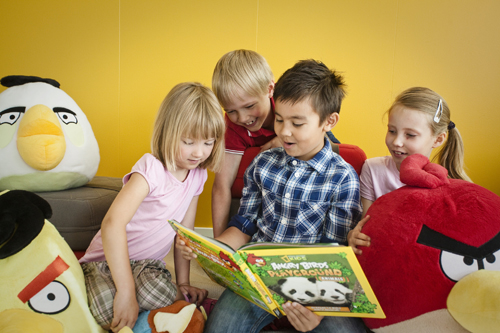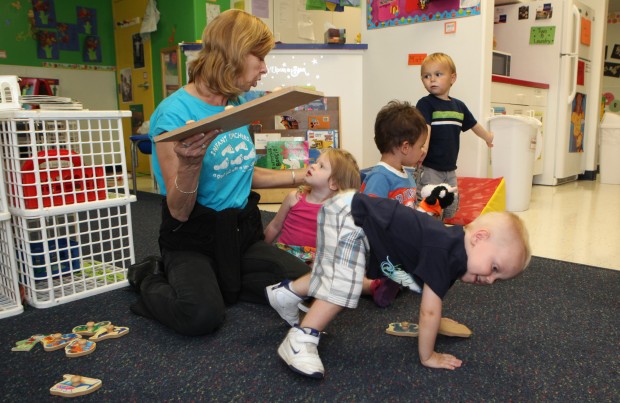The environment we are in affects our moods, ability to form relationships, effectiveness
in work or play—even our health. In addition, the early childhood group
environment has a very crucial role in children’s learning and development for
two important reasons.
Children need to explore, experiment, and learn basic
knowledge through direct experience. Indeed, childhood is a time when we learn
firsthand about the physical world the feel of water, the constant pull of
gravity, the stink of rotten fruit, and the abrasive feel of concrete on a bare
knee. Play provides a way for children to integrate all their new experiences
into their rapidly developing minds, bodies, emotions, and social skills. Brain
research supports this idea, stressing that children learn best through an
integrated approach combining physical, emotional, cognitive, and social growth.
The role of the teacher is critical in a child’s life. Children depend on
teachers to be their confidant, colleague, model, instructor, and nurturer of
educational experiences. Clearly children need lots of exposure to other people
in their early childhood years. One of the greater weaknesses of Western
society is that our children have less exposure to the diverse group of people
living in the local village—baker, farmer, gardener, carpenter, piano tuner,
bricklayer, painter, etc. Young children
need to feel important. In past eras children were responsible to water the
garden, do farm chores, and care for younger children. Children need to feel
that what they do is meaningful to someone besides themselves. A basic human
need is the need to belong. Children need to feel they belong, too. They need
to be close to people they know, have familiar and comfortable objects, and be
in a setting that has a personal history for them.
Childhood Environments:
Unlike traditional classrooms, early childhood environments
need to support both basic functions and learning activities. Look around your
classroom from a child's perspective. Are toilets, sinks, windows, faucets,
drinking fountains, mirrors, towel racks, chairs and tables, tooth brush
containers, and bulletin boards at the child's level and child-sized? Are
classrooms, bathrooms, kitchens, and eating areas close together so that
children can develop self-help skills and important autonomous behaviors? Like
children, teachers also need to have spaces that are functional. Teachers need
to be able to arrange and rearrange their classrooms for various class
activities and supervision purposes. Classrooms that include permanent,
built-in features such as lofts, playhouses, tables, benches, alcoves, and cabbies can be problematic. These types of fixed features make it difficult for
teachers to create areas for gross motor activities, can cause injury in active
children, or prevent inclusion of physical activities altogether. Classrooms
built as a basic shell work best.
Special Needs for children:
Even environments carefully designed and equipped for young
children do not meet the needs of children with disabilities. Adaptations must
be made carefully for any child with special needs, be they physical
challenges, learning disabilities, or emotional issues.
Diversity:
The environment should reflect the importance of children by
including examples of their work in progress, finished products, and by
displaying images of children. Every child in the program must see examples of
themselves and their family throughout the center, not just in the classroom.
Visual images are an important part of developing a feeling of belonging in all
children, so it is important to display pictures of single parent families,
grandparent families, and homes of every race and ethnicity, including
interracial, multicultural, and adoptive families. The entire center should also
reflect diversity throughout the world
race, ethnicity, languages (not just English and Spanish), art, gender
roles, religious ceremonies, shelter, work, traditions, and customs. The goal
is for children to be exposed to the rich diversity of the entire world
(Wardle, 1992). This is done through artwork, photos, posters, and signs on the
wall; books; dolls; parent boards, newsletters, announcements, and magazines;
and curricula materials such as puzzles, people sets, activity books, music,
art materials, artifacts in the dramatic play area, and fabrics.
Planning for Learning Environment:
When setting up an effective preschool classroom, a variety of factors must be carefully considered and balanced (Olds, 1982). Below are some of the critical environmental issues that must be carefully addressed as you plan the environment.
Storage areas are a little like entrance and exits—they
receive lots of traffic and are noisy and congested. For these reasons, storage
areas can sometimes foster disruptive behavior and noise. Provide easy access
to materials, allowing children to get what they need quietly and easily. The
closer materials are to where they will be used, the better. Storage must also
be designed so that materials for independent child use are separate from those
teachers control.
Activity areas need to be located next to supplies and be
easy to clean up. The classic example is the art area. While providing easy
access to paint, easels, paper, and brushes, the art area needs to be close to
a water source and on a surface that can withstand a mess. Similarly, the
reading area must be close to book shelves, magazine racks, and comfortable
places to sit.
Managing noise is important in a classroom. Placing carpet
on the floor absorbs noise as doe’s absorbent tile on the ceiling. The reading
center should be next to a quiet area like the art area. Blocks are loud, and
should be located next to other loud areas such as the woodworking bench. Noisy
activities can also be placed in transition areas or moved outside in good
weather.
Dividers are any physical object that serves to delineate
areas within a classroom, create interest areas, control traffic, and
distribute children throughout the classroom. Almost anything can be used as a
divider, so long as it is safe shelves,
couches, fabric hung from a line, streamers attached to the ceiling, folding
screens, puppet stages, etc. Safety is obviously a critical issue. Some
dividers are easy to push over. The larger and heavier they are at the bottom,
the safer. A divider can also be secured by fastening it to the floor or a wall.
Several equipment companies have introduced dividers that attach directly to
storage units and furniture. Ideally, dividers should be malty-functional for
use as storage units, play furniture, and display boards. Keep in mind that
solid dividers or walls of more than 30-40 inches high disrupt the circulation
of air in the classroom and limit supervision of children. Less solid dividers,
like fabric, avoid this problem. One teacher creatively used colorful fabric
streamers attached to the ceiling as effective dividers.
Evaluation for best Environment:
Carefully select the person who will conduct the evaluation.
The person should be objective and familiar with the program and children. Evaluate
the entire center, including the playground, hallways, and bathrooms. It makes
little sense for a program to have a nice, cozy, intimate classroom, with
learning centers and children's work displayed everywhere, and long, cold
institutional corridors and large bathrooms with adult-size urinals. Make sure
all the important objectives of the program are addressed. Most instruments
list each objective and items that support those objectives. Be particularly
attentive to ways the environment supports new program objectives. If the
program just added a technology objective, are there enough computers and a
well-equipped computer learning center? Ensure consistency. If the program
stresses developmentally appropriate practice and play, then the computer
component cannot be designed to support teacher directed instruction and drill/skill
activities. Balance what we know to be good for children with the new fixation
on academics. Many public schools and Head Start programs are emphasizing
teacher directed instruction in academics at the expense of meeting all the
children's needs. Make sure environments designed to support diversity address
all forms of diversity. It is as important for an all minority program to show
racial, ethnic, and national diversity as a white program; gender, language,
religion, ability, and occupational diversity should all be evident. Once the
evaluation is completed; the results should be tabulated, analyzed, and
communicated to the program's decision-makers. The information gained from an
evaluation is extremely valuable and can be used to design new programs and
offerings as well as construct the budget for the coming school year.
First, young
children are in the process of rapid brain development. In the early years, the
brain develops more synapses or connections than it can possibly use. Those
that are used by the child form strong connections, while the synapses that are
not used are pruned away. Children’s experiences help to make this
determination. The National Scientific Council of the Developing Child compares
the development of the brain to constructing a house stating, “Just as a lack
of the right materials can result in blueprints that change, the lack of
appropriate experiences can lead to alterations in genetic plans.” They further
state, “Building more advanced cognitive, social, and emotional skills on a
weak initial foundation of brain architecture is far more difficult and less
effective than getting things right from the beginning”. Because children’s
experiences are limited by their surroundings, the environment we provide for
them has a crucial impact on the way the child’s brain develops.
The second reason
that the early childhood group environment has such a strong role in children’s
development is because of the amount of time children spend in these
environments. Many children spend a large portion of their wakeful hours in
early childhood group settings. For example, a baby beginning child care will
spend up to 12,000 hours in the program. This is more time than he will spend
in both elementary and secondary school. Children will typically spend another
4,000 hours in kindergarten through third grade classrooms.
The early childhood
environment that this baby enters will reflect the teacher’s philosophy,
values, and beliefs about children and learning through either deliberate
design or lackadaisical overlook. It provides messages to all those who
enter—children, parents, and staff. Is this a place where I am welcomed and
where my physical, social, and intellectual needs will be met? Is this an
environment where I am seen as worthwhile and competent? Do I passively receive
information in this environment, or am I actively engaging in the construction
of knowledge? Does someone think I am special enough to provide a beautiful
environment for my benefit? Anita Rue Olds, a well-known environmental
designer, believes that we should design our early childhood environments for
miracles, not minimums. She states:
Children are
miracles. Believing that every child is a miracle can transform the way we
design for children’s care. When we invite a miracle into our lives, we prepare
ourselves and the environment around us. We may set out flowers or special
offerings. We may cleanse ourselves, the space, or our thoughts of everything
but the love inside us. We make it our job to create, with reverence and
gratitude, a space that is worthy of a miracle! Action follows through. We can
choose to change. We can choose to design spaces for miracles, not minimums.
A good early childhood environment meets the child's basic
needs and supports and encourages children to engage in activities that
implement the program's curriculum. Further, the environment is designed to
enable staff to facilitate the optimum learning for their children. Finally,
the environment makes parents and guardians feel welcome, involved, and
empowered.
Building a language
rich environment is, on the face of it, an easy thing to do. Unfortunately, in
today's busy households and with the busy lifestyles of parents who have to
work full-time, it is harder to find the time to spend with your children than
many of us realize. However, there are many opportunities to use and teach
language in everyday situations and create a good environment for learning.
 RSS Feed
RSS Feed Twitter
Twitter 05:10
05:10
 Unknown
Unknown






 Posted in
Posted in
0 comments:
Post a Comment